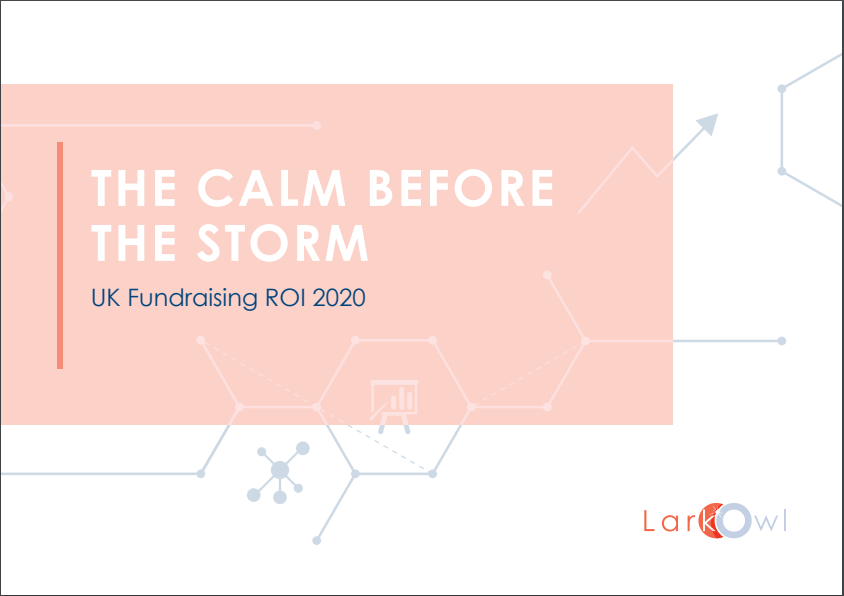Return on investment in fundraising: missed opportunities
Last month, charity consultants LarkOwl released ‘The Calm Before the Storm’, an updated analysis of the average returns on investment for varying types of fundraising activities. Caroline Danks, one of LarkOwl’s Directors, describes some of the areas where more charities could explore in order to maximise their income generation and returns on investment.
It’s difficult to highlight trends in a study with only 39 participants, but there are most definitely a few things which stood out to us as we were analysing and preparing the data in our report.
Gifts in Wills
This was the standout piece of data for me during the creation of this report:
Only 20 charities of the 39 respondents received income from Gifts in Wills.
Of these 20, only 11 invested in this area.
Now of course, those who didn’t receive any legacy gifts in 2019, may have received them in previous years. They may also have only just started on a legacy promotion programme (and of course, no-one would expect such a programme to bear short term fruit).
But this data backs up my years of experience working with charities which says that we’re still too awkward / shy / embarrassed to talk about gifts in wills.
• Maybe it’s the length of time I’ve spent working with Hospice clients?
• Maybe it’s the countless conversations I’ve had with volunteers and donors who have been only too happy to be open about their intentions (with ZERO awkwardness)?
• Maybe it’s having endured of being referred to as Dr Death by certain colleagues at a certain VERY large charity who should have had more respect for their supporters (a nickname which I found equally bemusing and offensive)?
I genuinely believe that reticence around legacy marketing sits firmly with the personal fears of internal staff and it HAS to stop because it’s getting in the way of both opportunities for long standing supporters who are likely keen to make their mark.
For charities looking to dip their toe into the water in this area, please check out my blog post on the topic.
Trading
Only 12 of the 38 participant charities reported any income from trading activities.
This would be understandable for small, start-up organisations but is surprising considering that most of the participants were from large charities (£1m plus) with well-established income
generating machines.
I have worked with charities large and small throughout our careers. Regardless of overall size, there are definite similarities between charities which have an established and successful trading arm and those who don’t.
Less reliance on fundraising due to supplementation by trading income leads to:
• Reduced short-term pressure on fundraising and an increased quality on donor relationships (allowing them to build naturally over time)
• Higher quality fundraising practice with more time for research, preparation, considered approaches
• More confidence in forward planning across organisations due to availability of funds and a greater diversity of funding sources
Although charities with both trading and fundraising income can sometimes tend towards relegating fundraising to a lower status, the absence of so much shot term pressure and ability to plan long term is worth the reduction in internal status for the freedom and flexibility it brings.
Trading shouldn’t be limited to heritage or tourism charities with space for cafes and shops. We know of a local hospice with a meal delivery service, a heart health charity with a hospital hotel for family members of patients and a homelessness charity with an HR consultancy. Explore the expertise of your staff team and trustees, brainstorm ideas, do your research and be conscious that all new enterprises take a while to become profitable (rather like fundraising!).
The case study in this blog post by LarkOwl’s Commercial Director, Tony Richardson may give you some inspiration.
Advertisement
Non-participation
Many of those asked to participate wanted to but said that they either ‘didn’t have the data to hand’ or ‘simply couldn’t justify the time in gathering the data’. For obvious reasons, this report will be considerably more meaningful to those who can overlay their own figures with the ‘averages’ from other charities.
• How can you possibly know how or what to improve if you don’t even know where you’re starting from?
• How can you make a business case for more investment if you have no baseline figures from which to begin your argument?
Challenges for gathering ROI figures for different types of fundraising include:
• A lack of knowledge about your own charity’s finances / room for improvement in your relationship with you finance team
• Breaking down of internal silos / collective responsibility for fundraising targets (this is a GOOD THING but you should still be able to monitor your ROI’s)
• A large, complex organisation with multiple fundraisers based across several locations in a variety of roles
Try to find a system for gathering ROI where possible. Maybe just start with your own role and encourage colleagues to do the same. Find a formula which can be repeated across your charities for individuals and teams and use it to gather information and make changes and improvements as you go.
Caroline Danks is Director of LarkOwl, a consultancy which supports charities to maximise their income from both voluntary and commercial sources. ‘The Calm Before the Storm, Fundraising Benchmarking 2020’ is free and available to download from their website.




